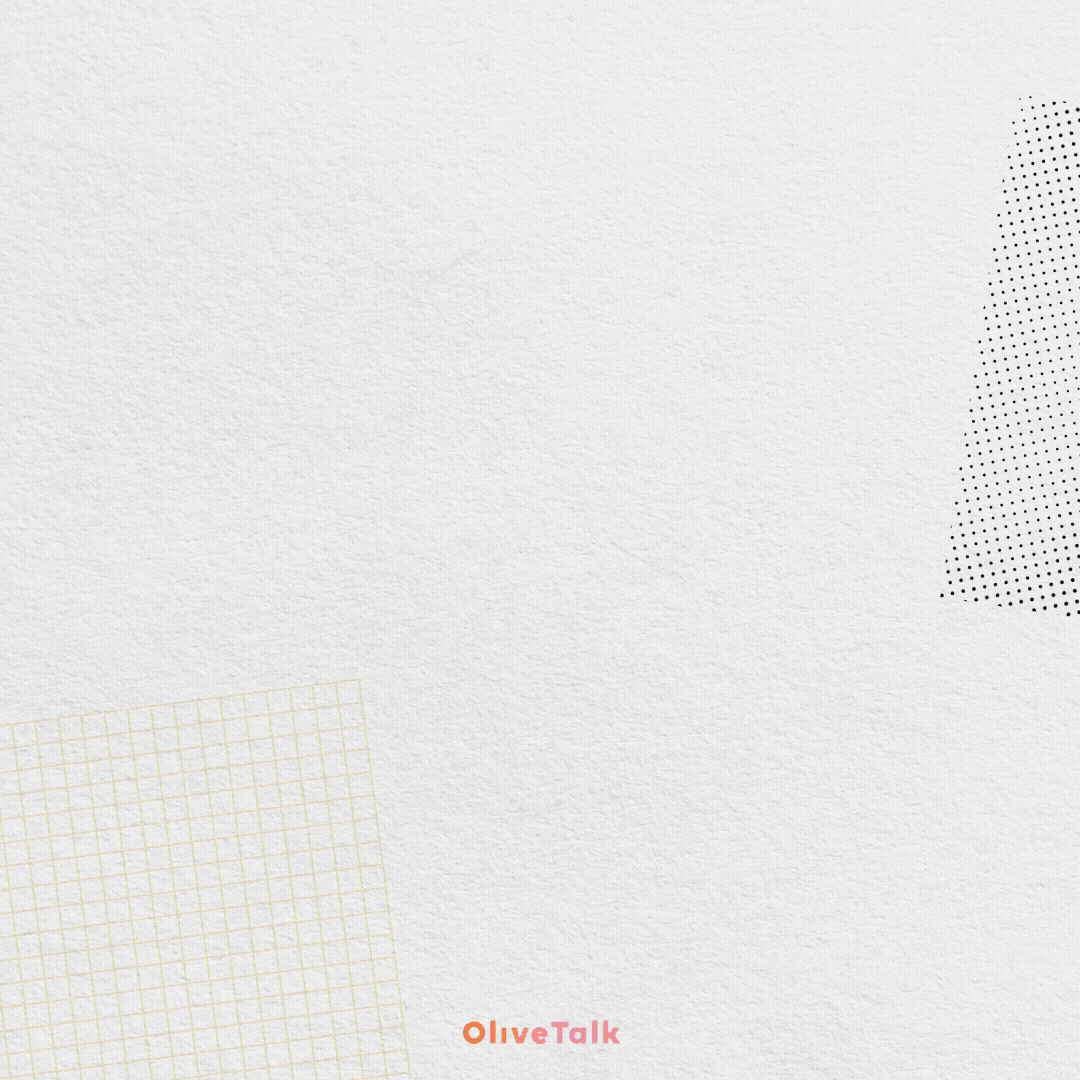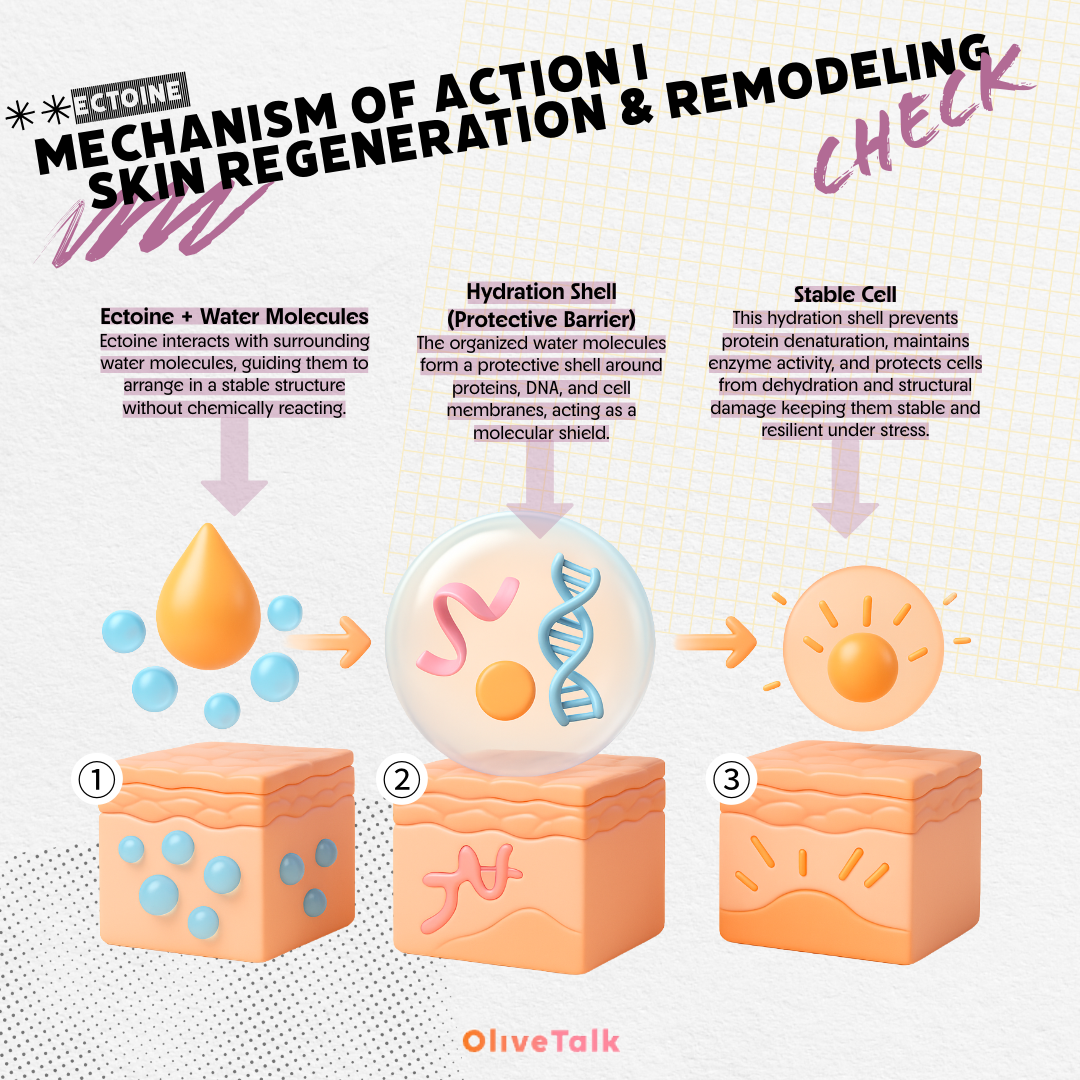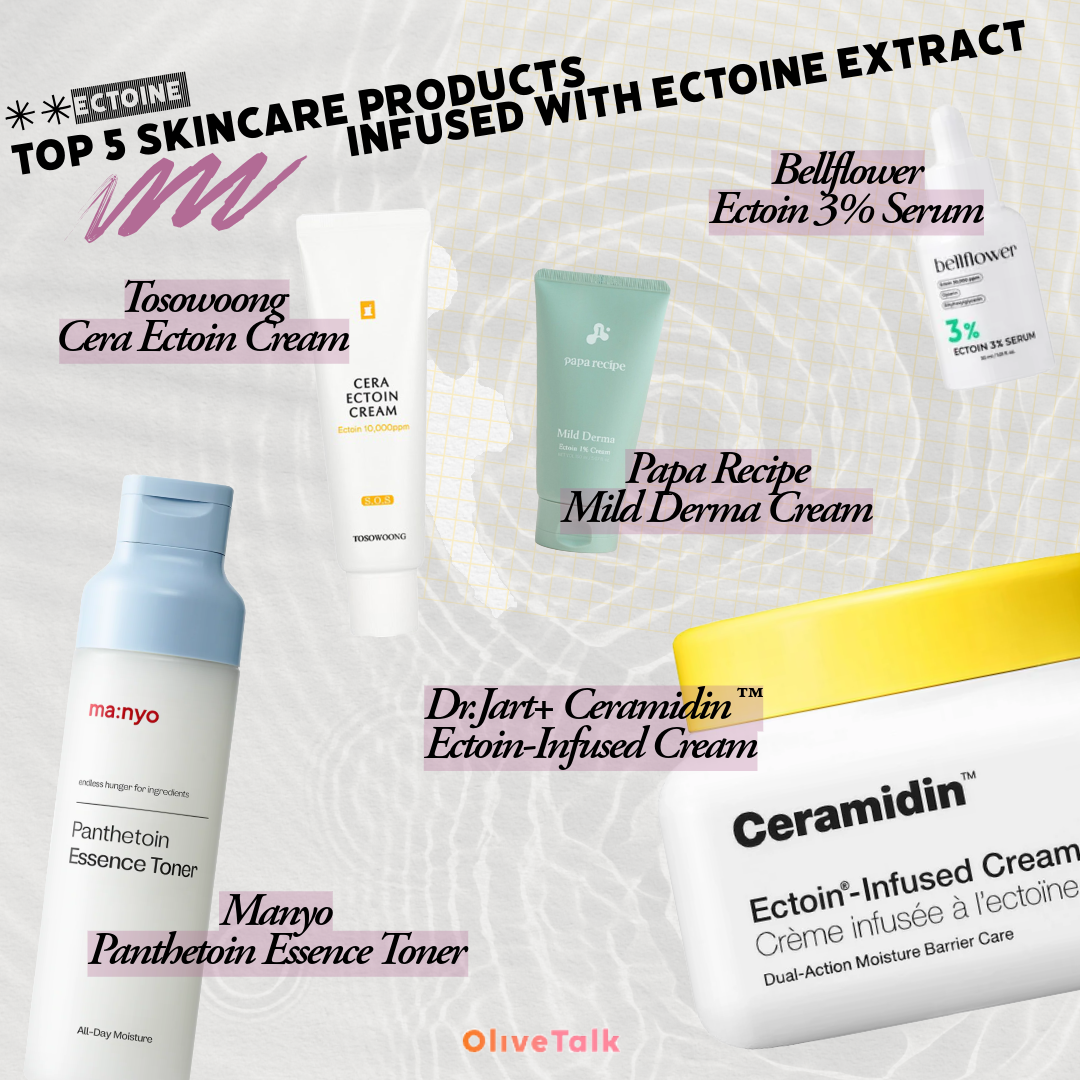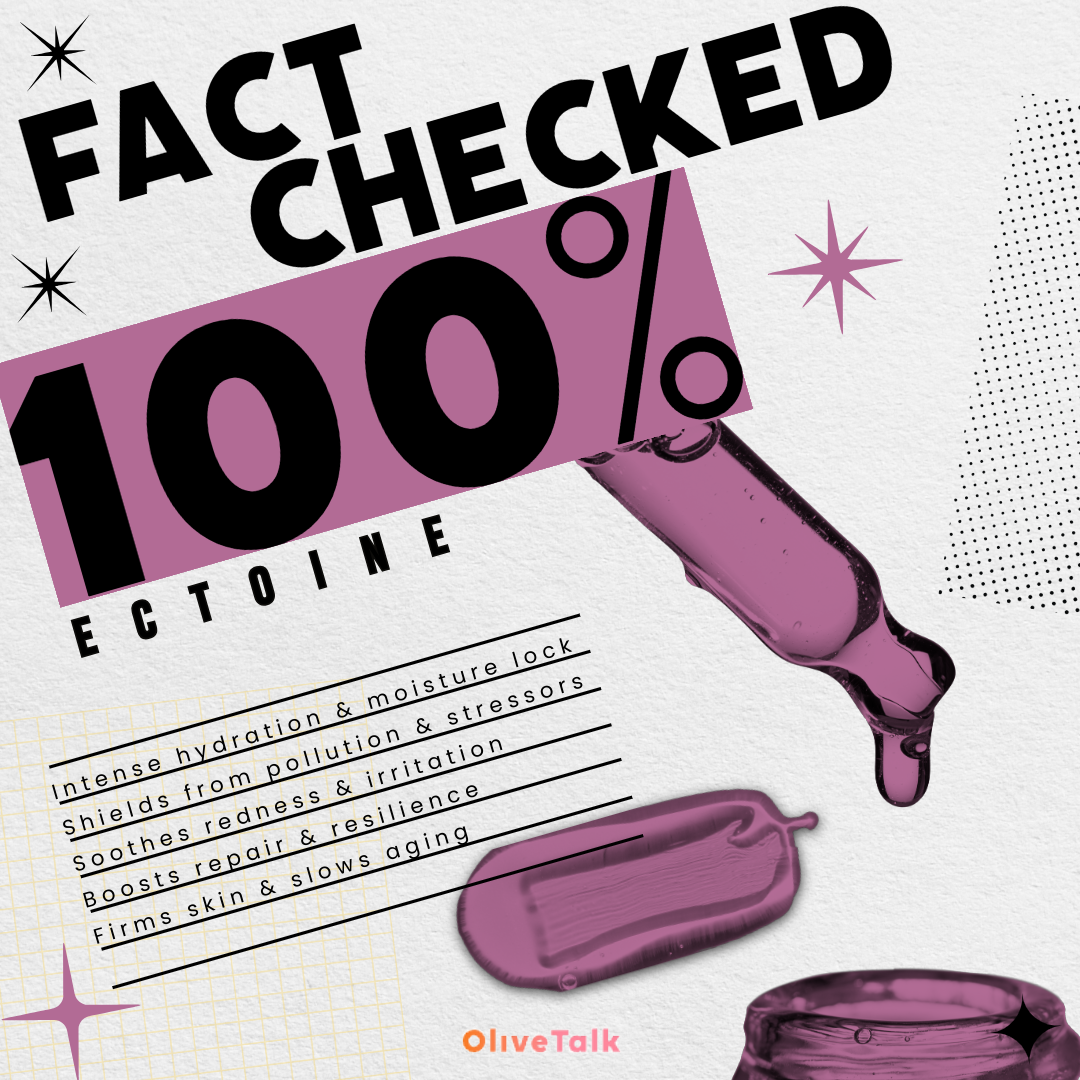

💧 What is Ectoine?
Ectoine is a low-molecular-weight amino acid derivative classified as an extremolyte, originally discovered in halophilic (salt-loving) bacteria such as Halomonas elongata. These microorganisms survive in high-stress environments like salt lakes and deserts by producing ectoine to protect themselves from extreme osmotic, thermal, and UV stress.
In skincare, ectoine is prized for its cytoprotective and hydrating abilities. It helps stabilize cell membranes, improve moisture retention, and protect skin from oxidative and environmental stressors.

🌿 Origins of Ectoine in Skincare
Ectoine was discovered in 1985 by Galinski et al. during a study on salt-tolerant bacteria. By the early 2000s, it began to emerge in skincare formulations due to its remarkable ability to 1)Stabilize proteins and lipid membranes, 2)Reduce inflammatory responses, 3)Enhance cellular resistance to UV and pollutants
It became a key ingredient in dermocosmetic lines focused on sensitive, atopic, and aging skin.
What is Ectoine and Where Does It Come From?
Ectoine is a powerhouse ingredient originally discovered in some of nature’s toughest survivors halophilic bacteria that thrive in extreme environments like salt lakes, deserts, glaciers, and hot springs. These microorganisms produce ectoine as a natural “stress-protection molecule” to shield themselves from UV radiation, dehydration, heat, and oxidative stress.
In modern skincare, ectoine is typically produced through biotechnological fermentation using the strain Halomonas elongata. This sustainable method allows us to harness the same protective benefits that help these microbes survive in the wild.
So, when you see ectoine on a label, think of it as a cell guardian an amino acid–derived molecule that strengthens skin resilience, locks in hydration, calms irritation, and helps defend against environmental aggressors.

🔬 Mechanism of Action I
1️⃣ Ectoine + Water Molecules
Ectoine interacts with surrounding water molecules, guiding them to arrange in a stable structure without chemically reacting.
2️⃣ Hydration Shell (Protective Barrier)
The organized water molecules form a protective shell around proteins, DNA, and cell membranes, acting as a molecular shield.
3️⃣ Stable Cell
This hydration shell prevents protein denaturation, maintains enzyme activity, and protects cells from dehydration and structural damage keeping them stable and resilient under stress.

🧪 Clinical Evidence & Optimal Concentrations
(Concentration / Key Effects / Clinical Findings)
- 0.2–0.5% / Skin hydration, TEWL reduction / 20% TEWL reduction in 2 weeks (Jung et al., 2016)
- 1% / Anti-inflammatory, skin barrier support / Improved recovery in atopic dermatitis patients (Pflugfelder et al., 2018)
- 2% / Pollution protection, wrinkle smoothing / Reduced wrinkle depth and skin roughness after 4 weeks (Grune et al., 2019)
🍉 Product Formats & Typical Percentages
(Product Type / Typical % Range / Target Benefits)
Serums / 0.5–2% / Barrier support, hydration boost
Creams / 0.2–1% / Skin soothing, inflammation relief
Ampoules / 1–2% / Pollution protection, oxidative stress defense
After-sun or anti-redness / 1%+ / UV stress recovery, calming
<Clinical Highlights : Ectoine in Action>
1. Rapid Plumping & Radiance Enhancement
A robust 2025 study combining probiotic intake with a topical formula containing Ectoine + hyaluronic acid (on 96 middle-aged subjects) reported
- Wrinkle depth reduced by 9.2% within 1 hour.
- Skin hydration improved by 16.6%.
- Radiance enhanced by 19.1%.
2. Soothes Post-Laser Damage: Enhancing Barrier Recovery
In patients post-CO₂ laser treatment, Ectoine-containing emulsions showed
- Moisture levels rose from 54.4 to 72.5 mg/cm².
- TEWL dropped from 6.2 to 5.3 g/m²·h.
- This indicates significant barrier restoration and redness reduction.
3. Hydration & Pruritus Relief in Atopic Dermatitis
A systematic review highlighted that 5.5–7.0% topical Ectoine
- Significantly relieved dryness and itching.
- Improved dermatitis severity scores.
- Was well tolerated in infants and adults, reducing the need for pharmacological therapy.
4. Long-Lasting Hydration Gains (Up to +200%)
In a 12-day corneometry trial
- Ectoine lotion (applied twice daily) boosted hydration by up to 200% compared to placebo.
- Impressively, skin hydration stayed elevated 7 days after stopping the treatment.

<Top 5 Skincare Products Infused with Ectoine Extract>
1. Bellflower – Ectoin 3% Serum
Content : 3%
Country : KR
2. Tosowoong – Cera Ectoin Cream
Content : 10,000 ppm
Country : KR
3. Dr. Jart+ – Ceramidin™ Ectoin-Infused Face Cream
Content : no information
Country : KR
4. Manyo (Ma:nyo) – Panthetoin Essence Toner
Content : no information
Country : KR
5. Papa Recipe – Mild Derma Cream
Content : 1%
Country : KR
🏃♂️ Historical Note: From Salt Lakes to Skin Cells
Initially studied for its survival role in extremophiles, ectoine entered pharmaceutical and cosmetic research in the late 1990s. Its utility in anti-aging, anti-inflammatory, and anti-pollution skincare has since expanded, especially in formulations aimed at urban, sensitive, or immunocompromised skin.
It is now considered a next-generation bioactive that is biodegradable, non-toxic, and safe for long-term use.
💾 Final Thoughts from a Skincare Expert
Ectoine is a smart, bioadaptive skincare ingredient that defends your skin at the cellular level.
Think of it as a molecular shield—preserving your barrier, calming irritation, and future-proofing your skin from environmental stress.
Especially valuable for sensitive or pollution-exposed skin types.

📚 References
Galinski, E. A., & Pfeiffer, H. P. (1985). Ectoine synthesis and function in halophilic bacteria. Archives of Microbiology, 142(3), 307–314.
Jung, S. et al. (2016). Moisturizing and anti-inflammatory effects of ectoine in healthy volunteers. Skin Pharmacology and Physiology, 29(5), 231–238.
Pflugfelder, A. et al. (2018). Ectoine-containing cream improves symptoms of atopic dermatitis. Journal of Dermatological Treatment, 29(2), 132–139.
Grune, T. et al. (2019). Anti-aging effects of ectoine in human skin: clinical evaluation and proteomic analysis. Experimental Dermatology, 28(7), 771–778.
https://olive-talk.com/talk/m/NApxRWz
 31Comments
31Comments
Definitely bookmarking🤗